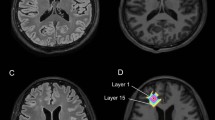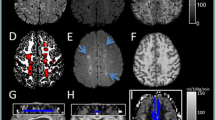Abstract
Brain aging affects an increasing segment of the population and the role of chronic cerebrovascular disease is considered to be one of the main parameters involved. For this purpose we compared retrospectively MRI data with digitized subtraction angiography (DSA) data in a group of 50 patients focusing onto the watershed area of the carotid artery vascular territories. In order to evaluate the presence of white matter lesions (WML) in the hemispheric watershed areas, coronal fluid-attenuated inversion-recovery or axial T2 weighted MRI images of patients with symptomatic cerebrovascular insufficiency areas were compared with the capillary phase of DSA studies in anterior–posterior projection. Presence of cerebrovascular occlusive disease was evaluated on DSA using North American symptomatic carotid endarterectomy trial criteria and including evaluation of collateral vascular supply. Pathological MRI findings in the region of the watershed territories correlated overall in 66% of cases with a defect or delayed filling on DSA. In the case of asymmetrical MRI findings, there was a pathological finding of the capillary phase in the watershed area in 92% of DSA studies. Hypoperfusion in the capillary phase of the watershed area as seen on DSA correlated with the stenosis degree of the concerned carotid artery. Our findings suggest that asymmetrical findings of WML in the watershed areas as seen on MRI are caused by hemodynamic effect and a differentiation between small vessel disease and a consequence of distant stenosis may be possible under such conditions.



Similar content being viewed by others
Abbreviations
- FLAIR:
-
Fluid-attenuated inversion-recovery
- WML:
-
White matter lesions
- DSP:
-
Digitized subtraction parenchymography
- DSA:
-
Digitized subtraction angiography
- ICA:
-
Internal carotid artery
- NASCET:
-
North American symptomatic carotid endarterectomy trial
References
Krapf H, Widder B, Skalej M (1998) Small rosarylike infarctions in the centrum ovale suggest hemodynamic failure. Am J Neuroradiol 19:1479–1484
Adachi T, Kobayashi S, Yamaguchi S, Okada K (2000) MRI findings of small subcortical “lacunar-like” infarction resulting from large vessel disease. J Neurol 247:280–285
Adachi T, Takagi M, Hoshino H, Inafuku T (1997) Effect of extracranial carotid artery stenosis and other risk factors for stroke an periventricular hyperintensity. Stroke 28:2174–2179
Gawne-Cain ML, Silver NC, Moseley IF, Miller DH (1997) Fast FLAIR of the brain: the range of appearance in normal subjects and its application to quantification of white-matter disease. Neuroradiology 39:243–249
Moody DM, Brown RW, Challa RV, Anderson LR (1995) Periventricular venous collagenosis: association with leukoaraiosis. Radiology 194:469–476
Mäntylä R, Aronen HJ, Salonen O, Pohjasvaara T, Korpelainen M, Peltonen T, Standertskjöld-Nordenstam CG, Kaste M, Erkinjuntti T (1999) Magnetic resonance imaging white matter hyperintensities and mechanism of ischemic stroke. Stroke 30:2053–2058
Theron J, Nelson M, Alachkar F, Mazia D (1992) Dynamic digitized cerebral parenchymography. Neuroradiology 34(4):361–364
Théron J, Nelson M, Alachkar F, Mazia D (1992) Dynamic digitized cerebral parenchymography. Neuroradiology 34:361–364
North American Symptomatic Carotid Endarterectomy Trial Collaborators (1991) Beneficial effect of carotid endarterectomy in symptomatic patients with high-grade carotid stenosis. N Engl J Med 325:445–453
Manolio TA, Burke GL, O’Leary DH, Evans G, Beachamp N, Knepper L, Ward B (1999) Relationships of cerebral MRI findings to ultrasonographic carotid atherosclerosis in older adulds. Arterioscler Thromb Vasc Biol 19:356–365
Read SJ, Pettigrew L, Schimmel L, Levi CR, Bladin CF, Chambers BR, Donnan GA (1998) White matter medullary infarcts: acute subcortical infarction in the centrum ovale. Cerebrovasc Dis 8:289–295
Schmidt R, Schmidt H, Kapeller P, Lechner A, Fazekas F (2002) Evolution of white matter lesions. Cerebrovasc Dis 13(Suppl 2):16–20
Hund-Georgiadis M, Ballaschke O, Scheid R, Norris DG, von Cramon DY (2002) Characterization of cerebral microangiopathy using 3 T MRI: correlation with neurological impairment and vascular risk factors. J Magn Reson Imaging 15:1–7
Kluytmans M, van der Grond J, van Everdingen KJ, Klijn CJM, Kappelle LJ, Viergever MA (1999) Cerebral hemodynamics in relation to patterns of collateral flow. Stroke 30:1432–1439
Acknowledgements
Dr. Lövblad is supported by a grant from the Swiss National Science Foundation (Grant 3100–066348.01.).
Author information
Authors and Affiliations
Corresponding author
Rights and permissions
About this article
Cite this article
Minkner, K., Lovblad, K.O., Yilmaz, H. et al. White matter lesions in watershed territories studied with MRI and parenchymography: a comparative study. Neuroradiology 47, 425–430 (2005). https://doi.org/10.1007/s00234-005-1358-8
Received:
Accepted:
Published:
Issue Date:
DOI: https://doi.org/10.1007/s00234-005-1358-8




